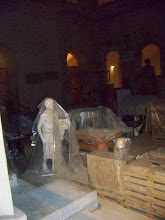
A month ago today, Moses and I took a long walk around parts of El Paso. We went to Ascaratre park and walked along the lake, and we drove to the outskirts of town and looked around.
Here’s some pictures, all of them taken on that day.
Ever since Moses and I have been friends, we sometimes walk around El Paso or Júarez with sketch pads or cameras, stopping at anything that strikes us as beautiful and trying to capture something about it, as if we were looking for treasure.
I remember when I was younger and I would walk into the field across the street from our house, or into a grove of fig trees or along the shores of Millerton Lake, and I would fantasize that I would stumble upon something valuable, a bag of money, an old coin, something that would change my life for the better.

This desire wasn’t unique with me, because on one level it was an impulse manufactured by the culture, the foundation of which is built on the economic system. It was a time when people walked along beaches and into fields and meadows with metal detectors, hoping to find some precious relic. When I was a teenager, the neighbor kid got a metal detector for Christmas, and he was so excited, certain that he would find many valuable things.
When Moses and I walk around El Paso, we too are open to discovering treasure, but we’re looking for things that we can’t possess, an idea, a feeling, a thought, the feel of a tree’s texture.

One time we went into Juarez and spent about an hour with some kids, street vendors, and we bought them sodas and drew their pictures and listened to them giggle. Moses gave them some paper and pens and they drew us and each other.

I’m in Buenos Aires today, where I’m working on my autobiography, my life story, which is painful to do. Each day I enter into the landscape of my past, and I encounter myself at different stages of my life, and it’s hard. There are some versions of me that I don't think I would get along with if we had to be in the same room together.
In many ways my life is the story of desire evolving.
Like I tell my fiction writing students, in character-based literary fiction, plot equals character over time, and the characters are driven by need, by yearning, by desire.

P=Ch(y)/T, where “y” is yearning.
.
Often, the irony of fiction is when the desire is unknown to the character him or herself, that is, they think they want one thing, but what they really want is quite different from what they’re after.
To think of my life story thus far is a painful comedy, so much time chasing after the wind, but I know it’s something I need to share.

The other day, in a used bookstore on Avenida Santa Fe, I found up a title called “Siete conversaciones con Adolf Bioy Casares” which I immediately bought.
I read this today, in a conversation he was having about what it means to be a writer:
“A veces he pensando en buscar objectos de felictdad que no cesarean en el momento de la posesion.”
I know this is a pretty standard idea, but it connects me to another idea that I find interesting.
Desire itself is the goal, the meaning, the value, not the fulfillment of the desire. The value of desire is not the possession of the object that is desired or the achievement of a desired experience, but desire itself.
Desire is pure and beautiful, because it is the will to live, no matter how mundanely it’s manifested.

Unfortunately desire can also lead to destruction, to bad things, when it is thought of as a goal that must be achieved, at whatever cost, no matter who we perceive to be in the way. We have the capacity to hurt ourselves and so many others in the pursuit of satisfying our desire.
This is an abandoned house we found on the outskirts of town, where some junkies broke into and smoked their crack or meth or both.

Still, desire itself is pure, because it comes from the same source as the will to live, it is energy, and, to cornily quote Blake, Energy is eternal delight.
That’s why young people are so full of light and life.
They are filled with desire.
Like the preacher says, Rejoice in your youth!
But to get back to walking with Moses. We go anywhere, without a destination in mind.
Sometimes when we see something that strikes us, it does so because it carries its own desire.

We sense the energy behind an image.
Sometimes I feel like a kid using a spiritual metal detector, and I kid you not, as we were walking along a path, I found this.
Happiness on the path.

I enjoyed the serendipity, but I didn’t pick it up.










































